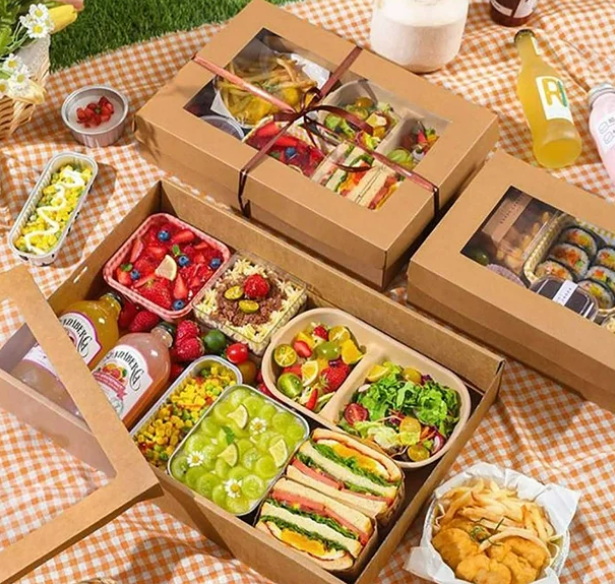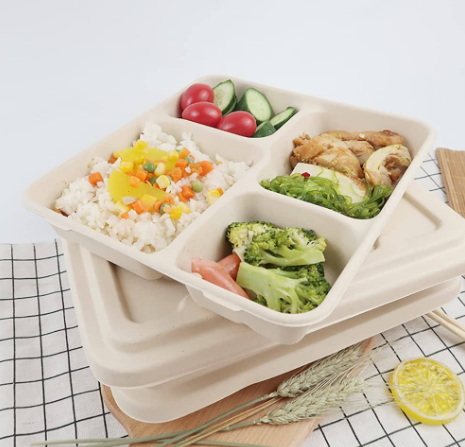
Content Menu
● Introduction to Disposable Lunch Boxes
>> Types of Disposable Lunch Boxes
● Wholesale vs. Retail Pricing
>> Factors Influencing Wholesale Prices
>> Benefits of Buying Wholesale
>> Retail Pricing
● Disposable Lunch Box Wholesale Suppliers
>> GMZ - Custom Paper Lunch Boxes
>> Paperware - Eco-Friendly Options
>> Mahalaxmi Flexible Packaging
● Benefits of Buying Disposable Products in Bulk
>> Cost Savings
>> Streamlined Inventory Management
>> Enhanced Operational Efficiency
● Factors Impacting Wholesale Packaging Pricing
>> Material Types
>> Quantity of Materials
>> Design and Customization
>> Manufacturing Process
>> Raw Materials Costs
>> Supplier Relationships
>> Sustainability Considerations
>> Transportation and Logistics
● Wholesale Pricing Strategies
● Market Trends and Consumer Preferences
● Challenges in Wholesale Purchasing
● Conclusion
● Frequently Asked Questions
>> 1. What are the benefits of buying disposable lunch boxes in bulk?
>> 2. How do I choose the right material for my disposable lunch boxes?
>> 3. Can I customize my disposable lunch boxes with branding?
>> 4. What are the environmental impacts of disposable lunch boxes?
>> 5. How do I ensure compliance with health and safety regulations when purchasing disposable lunch boxes?
● Citations:
Disposable lunch boxes have become a staple in modern life, offering convenience and practicality for individuals on-the-go. Whether you're a parent packing a child's lunch, an office worker, or a business owner looking to supply your employees or customers, disposable lunch boxes are an essential item. This article will delve into the comparison between wholesale and retail prices for disposable lunch boxes, exploring the benefits of purchasing in bulk and the factors that influence pricing.

Introduction to Disposable Lunch Boxes
Disposable lunch boxes are available in various materials, including paper, plastic, and stainless steel. Each material type has its own set of advantages and disadvantages. For instance, paper lunch boxes are eco-friendly and biodegradable, while plastic ones are often more durable and water-resistant. Stainless steel options are reusable and can keep food at the desired temperature for longer.
Types of Disposable Lunch Boxes
1. Paper Lunch Boxes: These are made from recyclable materials and are ideal for businesses aiming to reduce their environmental footprint. They are lightweight and can be customized with various designs.
2. Plastic Lunch Boxes: Known for their durability and affordability, plastic lunch boxes are widely used. However, they have environmental drawbacks due to their non-biodegradable nature.
3. Stainless Steel Lunch Boxes: Although not disposable in the traditional sense, these are often included in discussions about lunch boxes due to their reusability and eco-friendliness.
Wholesale vs. Retail Pricing
Wholesale pricing for disposable lunch boxes is generally lower than retail pricing due to the bulk quantities involved. This makes wholesale purchasing an attractive option for businesses or individuals who need large quantities of lunch boxes.
Factors Influencing Wholesale Prices
1. Quantity: The more you buy, the lower the price per unit. Wholesale suppliers often require a minimum order quantity to offer the best rates.
2. Material: The cost of materials directly affects the wholesale price. For example, paper lunch boxes are typically cheaper than plastic or stainless steel options.
3. Customization: Adding custom designs or branding can increase the cost per unit.
4. Supplier Location: Prices can vary based on the supplier's location due to differences in production costs and shipping expenses.
Benefits of Buying Wholesale
- Cost Savings: Purchasing in bulk reduces the cost per unit significantly.
- Convenience: Having a large stock of lunch boxes on hand can be convenient for businesses or large families.
- Customization Options: Wholesale suppliers often offer customization options that can enhance branding or appeal.
Retail Pricing
Retail prices are higher due to the smaller quantities sold and the additional costs associated with retail operations, such as store overheads and marketing expenses. However, retail purchases are more convenient for individuals who only need a few lunch boxes at a time.
Disposable Lunch Box Wholesale Suppliers
Several companies specialize in wholesale disposable lunch boxes, offering a range of products and customization options.
GMZ - Custom Paper Lunch Boxes
GMZ is a leading disposable food packaging manufacturer in China, offering high-quality cardboard boxes for bento, lunch, salad, fruits, etc. Their food boxes are built to last, eco-friendly, and engineered to keep meals fresh. The paper used in their bento boxes is SGS-approved for safe food contact and tested to be PFAS-free[3].
Paperware - Eco-Friendly Options
Paperware offers a huge range of wholesale food containers, including eco-friendly and recyclable options. They provide next-day shipping and free shipping to certain areas, making them a convenient choice for businesses looking for sustainable packaging solutions[4].
Mahalaxmi Flexible Packaging
Located in Ghaziabad, India, Mahalaxmi Flexible Packaging is a trusted supplier of disposable lunch boxes. They offer a variety of packaging solutions with competitive pricing and reliable service[5].

Benefits of Buying Disposable Products in Bulk
Buying disposable products in bulk offers several benefits for businesses, including significant cost savings, streamlined inventory management, and enhanced operational efficiency. By purchasing in larger quantities, businesses can ensure a consistent supply of essential items, reduce delivery frequency, and improve planning and forecasting[1].
Cost Savings
One of the most compelling reasons to purchase disposable products in bulk is the cost savings. The unit cost per item decreases significantly when buying in bulk, which can lead to substantial savings over time. This is particularly beneficial for businesses that use large quantities of disposable items regularly.
Streamlined Inventory Management
Bulk buying simplifies inventory management by reducing the frequency of reordering. With a larger stock of disposable products, businesses spend less time placing orders and managing deliveries. This streamlined approach not only saves time but also reduces the administrative burden associated with frequent reordering and tracking.
Enhanced Operational Efficiency
When businesses buy disposable products in bulk, they benefit from fewer deliveries. This reduces the logistical complexity of managing frequent shipments and minimizes disruptions to operations. Fewer deliveries also translate to lower shipping costs and less time spent on receiving and stocking items.
Factors Impacting Wholesale Packaging Pricing
Several factors influence wholesale packaging pricing, including material types, quantity of materials, design and customization, manufacturing process, raw materials costs, supplier relationships, sustainability considerations, and transportation and logistics[2].
Material Types
The choice of material for wholesale packaging is crucial. Materials like cardboard, paper, glass, metal, and plastic are commonly used. Each material has specific requirements and costs, which affect the overall pricing strategy.
Quantity of Materials
The quantity of materials used in each wholesale shipment impacts pricing. While some shipments require minimal materials, others, especially those containing fragile items, may need more materials to ensure product protection.
Design and Customization
Design and customization play a significant role in wholesale packaging. Even in bulk, products remain a reflection of the brand, and customization can increase costs but enhance brand visibility.
Manufacturing Process
The manufacturing process affects pricing due to factors like production location and complexity. Domestic production may be more expensive due to higher labor costs, while overseas production can be cheaper but involves import costs.
Raw Materials Costs
Raw materials costs are a key factor in determining wholesale prices. Changes in material sourcing or supply chain dynamics can lead to price adjustments.
Supplier Relationships
Strong supplier relationships can lead to better pricing and service. Suppliers may offer discounts or priority service to loyal customers.
Sustainability Considerations
Sustainability is increasingly important in packaging. While it may add costs, eco-friendly packaging can enhance brand image and appeal to environmentally conscious consumers.
Transportation and Logistics
Transportation costs are significant in wholesale due to the large volumes involved. Shipping by pallet or container requires careful planning and can impact pricing.
Wholesale Pricing Strategies
Wholesale pricing strategies involve offering price breaks and volume discounts for bulk orders. The unit cost is determined by the minimum order quantity (MOQ), and higher volume orders receive better deals. Wholesale customers understand that pricing fluctuates based on factors like delivery and shipping rates[2].
Market Trends and Consumer Preferences
Market trends show an increasing demand for eco-friendly and sustainable packaging options. Consumers are more likely to choose products with recyclable or biodegradable packaging, which can enhance a company's brand image and attract environmentally conscious customers[4].
Challenges in Wholesale Purchasing
While wholesale purchasing offers many benefits, there are challenges to consider. One of the main challenges is the need for adequate storage space to accommodate bulk quantities. Additionally, managing inventory effectively to avoid stockouts or overstocking is crucial.
Conclusion
In conclusion, wholesale prices for disposable lunch boxes are significantly lower than retail prices, making bulk purchasing an economical choice for businesses or large families. The choice between wholesale and retail depends on the quantity needed and the specific requirements of the buyer. Whether you prioritize eco-friendliness, durability, or affordability, there are numerous options available in the market.

Frequently Asked Questions
1. What are the benefits of buying disposable lunch boxes in bulk?
Buying disposable lunch boxes in bulk offers several benefits, including cost savings, convenience, and customization options. Wholesale pricing is generally lower than retail, making it more economical for businesses or large families.
2. How do I choose the right material for my disposable lunch boxes?
Choosing the right material depends on your priorities. Paper lunch boxes are eco-friendly and biodegradable, while plastic ones are more durable and water-resistant. Consider factors like sustainability, durability, and cost when making your decision.
3. Can I customize my disposable lunch boxes with branding?
Yes, many wholesale suppliers offer customization options, including branding and design. This can enhance your business's visibility and appeal to customers.
4. What are the environmental impacts of disposable lunch boxes?
Disposable lunch boxes, especially those made from plastic, can have significant environmental impacts due to their non-biodegradable nature. Opting for eco-friendly materials like paper or recyclable plastics can help reduce waste.
5. How do I ensure compliance with health and safety regulations when purchasing disposable lunch boxes?
Ensure that your supplier complies with local health and safety regulations, especially regarding materials that come into contact with food. Look for certifications like BPA-free for plastic products to ensure safety.
Citations:
[1] https://kitchendance.com/blogs/default-blog/the-benefits-of-buying-disposable-products-in-bulk-for-your-food-business
[2] https://www.paramountglobal.com/knowledge/factors-impacting-wholesale-packaging-pricing/
[3] https://gmz.ltd/application/wholesale-kraft-paper-lunch-boxes-supplier/
[4] https://paperware.com.au/disposable-packaging
[5] https://dir.indiamart.com/impcat/disposable-lunch-boxes.html
[6] https://www.econo-pak.com/advantages-of-bulk-food-packaging/
[7] https://www.infinitiresearch.com/thoughts/factors-affecting-packaging-costs/
[8] https://www.alibaba.com/showroom/wholesale-disposable-lunch-boxes.html
[9] https://www.bluecart.com/blog/wholesale-plastic-containers
[10] https://www.alibaba.com/showroom/disposable-lunch-box-factory.html
[11] https://www.made-in-china.com/products-search/hot-china-products/Disposable_Lunch_Box.html
[12] https://www.yoonpak.com/food-packaging-by-application/lunch-boxes/
[13] https://www.ibisworld.com/united-states/industry/paper-bag-disposable-plastic-product-wholesaling/962/
[14] https://www.alibaba.com/showroom/disposable-lunch-boxes-wholesale.html
[15] https://www.justdial.com/india/Disposable-Lunch-Box
[16] https://diyecobox.com/restaurant-packaging-costs-how-much-is-spent/
[17] https://www.justdial.com/Bangalore/Disposable-Lunch-Box-Wholesalers/nct-11637368
[18] https://www.mviecopack.com/disposable-lunch-box/
[19] https://www.verifiedmarketresearch.com/product/lunch-box-market/
[20] https://www.thecustomboxes.com/blog/6-factors-that-affect-the-burger-packaging-box-prices/

















